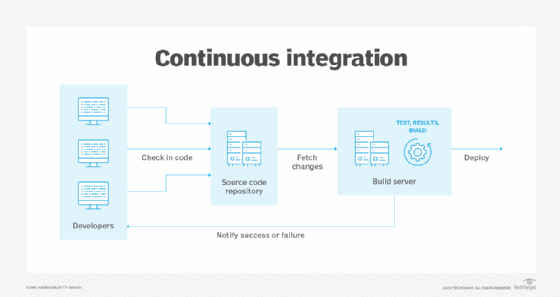What is a build server?
A build server, also called a continuous integration server (CI server), is a centralized, stable and reliable environment for building distributed development projects. The build server starts with a clean slate, so no unapproved configurations or artifacts are present.
The build server is a key component of continuous integration, which is the practice of automatically and regularly integrating code changes from multiple developers working with the same codebase. Continuous integration is typically part of a larger continuous integration/continuous delivery (CI/CD) framework. Continuous delivery is concerned with deploying the software to testing, staging and production environments.
The build server automatically performs the tasks necessary to support a collaborative and ongoing development effort. The server also ensures that the developer's code, after it is checked into the source code repository, can be safely integrated into the application. If there are any issues with the code, the server notifies the developers so they can correct and resubmit their code. Otherwise, the server packages the code and hands it off for deployment. In this way, the CI server helps support the entire CI/CD pipeline.
What is the role of the build server in CI?
Development teams that set up a CI environment typically implement the build server along with a version control system, such as Git or Subversion, which manages a project's source code and other related files.
When building an application, developers periodically check their code into the version control repository, which, in turn, can be accessed by the build server. The build server does all the heavy lifting during the CI process. It works directly with the source code repository, fetching the code as it is updated. It then verifies the code, builds the application, runs multiple tests and performs other actions.

During a project's software development phase, developers continuously merge their code into the source code repository. The build server automatically fetches the latest code from the repository either upon check-in or on a scheduled basis. The server then performs several operations, including the following tasks:
- Builds the application. The CI server automatically triggers the build process and compiles the code, using the most recent code checked into the repository. To ensure consistent builds, the server uses build scripts or configuration files, which are typically stored with the source code.
- Runs multiple tests. The server automatically runs integration and unit tests, along with any other configured tests. The tests ensure that no check-in breaks the build. The server also verifies the code and checks it for quality.
- Reports on the build progress. The server automatically provides developers with the results of the build process. In this way, they know immediately if there are any problems with the code they've checked into source control.
- Logs events. The server logs all events related to the build process. If there is a problem with a build, developers can refer to the logs to get at an issue's root cause. The server also maintains a history of the builds, which developers can reference to gain insights into their development projects.
- Packages the application. The build server packages the application so it is ready for deployment to the testing, staging and production environments. The server often hands the package off to a deployment platform or performs some other action to trigger the deployment process.
A build server can typically integrate with other tools to better accommodate development workflows. For example, a build server commonly integrates with version control systems and deployment platforms, as indicated above. However, it might also integrate with tools for ensuring code quality, tracking issues or facilitating collaboration between developers.
Why is the build server important to CI?
Development teams are not required to deploy a build server to support their CI efforts. However, without one, many tasks must be performed manually, resulting in delays, inconsistencies and inefficient workflows. A build server helps to address these issues by offering several benefits:
- Efficiency. A build server can help simplify and standardize the development process. It leads to faster deployments, improved productivity and more reliable deployments. A build server also streamlines development workflows, while providing faster feedback and earlier detection of code issues.
- Collaboration. The build server provides a central coordination point for building an application as a single collaborative effort. It enables multiple developers to work on the same codebase concurrently, while minimizing conflicts, maintaining consistency and ensuring code integrity.
- Quality assurance. The build server plays a vital role in ensuring the quality of the code and, subsequently, the application. The immediate feedback helps minimize technical debt and maximize quality over time.
- Automated testing. The build server automatically runs multiple tests with each build. Code issues are quickly detected and reported back to the developers, who can address them immediately while they're still manageable. The automated tests also identify integration and dependency issues, helping avoid major issues later.
- Consistency. The build server provides a consistent build environment for ensuring that each build uses the same configurations, while facilitating consistent deployments across multiple environments. The server also ensures code consistency by enforcing coding standards and uniform practices.
In the past, most development teams deployed build servers on their own infrastructure, but now, they often use cloud services that provide CI server capabilities, eliminating the need to implement and maintain their own infrastructure. Cloud services also offer a level of flexibility and scalability that is difficult to achieve with in-house deployments.
There is a lot to consider when implementing CI/CD to transform an organization. Explore this comprehensive guide, which explains the CI/CD pipeline stages, benefits and challenges, best practices and more.





